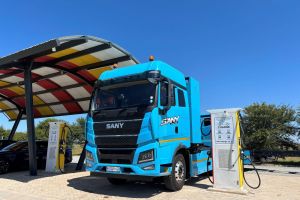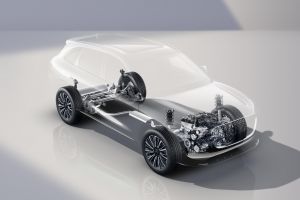
Charging an electric truck with off-grid solar power
A historic milestone has been reached with the opening of South Africa's first off-grid solar station for electric trucks.
- New Energy Vehicles
- 16 January 2026
Toyota has introduced a rebadged Suzuki Baleno to fill the gap left by the discontinued Etios.

Toyota and Suzuki recently announced this joint venture where Suzuki would benefit from Toyota’s hybrid technology and autonomous driving, while Toyota would get access to compact vehicles, a Suzuki strength.
Toyota says joint ventures, mergers, acquisitions and cross-brand partnerships are the driving forces of an ever-increasing global market. More recent examples are Toyota and BMW (Toyota Supra/BMW Z4 and Toyota Aygo/Peugeot 108/Citroën C1).
Toyota decided on the Starlet nameplate, which is part of the manufacturer’s hatchback history from 1973 in the Japanese domestic market for five generations, ending in 1999.
Like the Baleno, the exterior follows a classic hatchback profile, with a short, downward-sloping nose with a v-shaped front grille in Toyota-specific finishing.
The rear design centres on the large LED tail lamps with red and translucent accents. These are joined by a stylish chrome garnish strip and trapezoidal indent in the lower bumper section.
Inside the Starlet is spacious and in the centre in front is a ‘hang-down’ section of the dashboard with the neat grouping of the ventilation, infotainment and climate-control switchgear. In the centre is Multi-Information Display (MID) and dual analogue gauges.
A chunky three-spoke steering wheel incorporates steering switches and cruise control (where equipped).
The Xi model is equipped with 15” steel wheels shod with 175-65R15 tyres and a space-saver spare wheel. Xs and Xr variants feature stylish turbine-shaped 16” alloy wheels with 185-55R16 rubber.
Powering the Starlet is a 1.4-litre DOHC four-cylinder engine. Featuring Variable Valve Timing (VVT) and a tumble-flow intake manifold, the engine exhibits a rev-happy character and makes light work of the daily commute. Power output is pegged at 68 kW and 130 Nm.
Two transmission choices are on offer, a 5-speed manual and 4-speed automatic, all driving the front wheels. The obligatory 0-100 km/h dash is dispatched in 10.9 s for the manual and 11.6 s for the auto variant.
A three-grade strategy has been adopted using the familiar Xi, Xs and Xr symbols used across Toyota’s other passenger-car ranges. Despite serving as the entry point to the Starlet range, the Xi model is generously specced with the Xs model adds alloy wheels. The flagship Xr models receive the full package, including LED + Projector headlamps with daytime running lights (DRL), side-mirror mounted indicators and a roof spoiler. Moving to the interior, the spec level is amped up courtesy of a digital speedometer with colour MID, park distance control (PDC), reverse camera, climate control and push-start operation. Cruise control is also provided.
Xi and Xs models feature a double-DIN audio system with CD/Bluetooth/USB/Aux functionality, playing through six speakers. Xr models offer a feature-rich touchscreen audio system complete with Android Auto and Apple CarPlay integration for navigation, telephone and music-streaming services.
All Starlet models are also equipped with the Toyota Connect telematics system, which includes an in-car Wi-Fi hotspot and complimentary 15GB data. Once linked to their profile, customers can manage their vehicle via the MyToyota App.
This intuitive app allows on-demand service bookings, vehicle information and history, tracking data as well as Toyota Connect data recharge services and much more.
When it comes to pricing, the Starlet undercuts its Baleno clone somewhat, but the Suzuki makes up for it in a longer warranty and longer service plan than is the case with the Starlet.
Starlet 1.4 Xi MT (R204 900)
Starlet 1.4 Xs MT (R215 200)
Starlet 1.4 Xs AT (R235 700)
Starlet 1.4 Xr MT (R258 500)
Starlet 1.4 Xr AT (R272 500)

Tata Motors South Africa plans to launch an additional two new models during the course of the year.

Lepas, part of the global Chery Group, will officially enter the South African market in February 2026, bringing a new vision of modern automotive elegance with the L4, L6 and flagship L8, the brand says.

BYD has added another model to its line-up in South Africa. This time it is the Sealion 5, which slots in below the larger Sealine 6, which is also available locally.